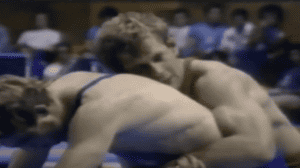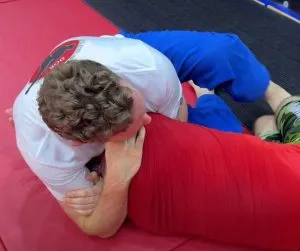One of the most common issues plaguing BJJ competitors is the fact that most practitioners cannot pull off the takedowns they train in competition. We have all seen it, 2 world class competitors standing and pushing each other, grabbing one another’s heads, standing erect and looking apprehensive to commit to the throw/takedown.
This can be due to a few different reasons such as:
1. They only practice rolling from their knees
- They only practice takedowns technically and not with any type of sparring
- Their BJJ instructor does not have proper knowledge in the intricacies of wrestling
- They are afraid to make mistakes
- They do not know how to setup and finish the takedown when pressure is added in the equation
- Mentally the athlete is not confident when it comes to taking someone down properly
There is good news as with these small tips and pointers, you can truly improve your BJJ standing game and start hitting more and more takedowns with success.
Pressure and Not Staying in the Pocket
Let’s get this right……Pressure…is…EVERYTHING. Pressure creates opponents to move, it creates them to make mistakes and eventually leads to the openings that are needed for a grappler to capitalize on.
What Do You Mean by Pressure
Most BJJ schools teach takedowns off a certain distance, generally known as the pocket, but they do not teach the most essential part which is using pressure to create openings. This can be a collar tie where you push the opponent forward and when they push forward you perform a snapdown into a front headlock or iit can be pressure off a collar tie into a Russian tie and taking a single leg.
Pressure also means letting your opponent constantly carry your weight whenever you can, it can be off of a 2-on-1, it can be on a front headlock, it can be on a whizzer and basically it means use your weight to never give your opponent time to rest when in contact with them.
Wherever you look, you need pressure to start the takedown engine, without this pressure and being used to having pressure placed on you, you will simply freeze up and not be successful at the takedown.
How Can I Train Pressure
The good news is there are drills to train pressure, here are a few to add into your training:
With a partner –
- Stand chest to chest, hands behind your backs and press your chests against each other while pushing forward, as you get better, change the angles you are pushing forward to and try to get around your training partner.
- Work off of specific grips where the body is not face to face, what does this mean….it means to work off a Russian tie, or a single underhook to one side. What this does is teaches the athlete to understand pressure is not just a forward action but is to be used multi-directionally.
- Pummeling….but proper pummeling, where you are moving your feet, pushing forward with some force and trying to attain double underhooks. This can start at 10% pressure and move up to 20% and even up to 100% as time and skill level goes by
- Another variation is pummeling and trying to attain an arm drag but with pressure moving forward, changing directions
- Yet another thing to add is to have the athletes sprawl quick and get back to pummeling with pressure each time the instructor whistles/claps
Work on Your Grips and Grip Fighting
Getting a proper grip and position is a huge factor if not the biggest factor in dominating your opponent and winning for that takedown.
The importance of grips is very underrated within BJJ schools when standing as most of the focus is done on the actual movement of the takedown but not on the setups.
Getting a good grip enables you to establish control, it enables you to control ultimately the hip position of your opponent, it enables you to move your body to when it needs to be and lastly it enables you to influence where your opponents foot placement will ultimately be.
In order to get good at grip fighting you need to do it, practice it each training session, even if for a minute or 2 but do it properly.
- Try to work it off of some pressure, no need to go 100% here to start but some pressure, even if 5%.
- Remember to move your feet properly and use your weight when you can, this will help you learn to both penetrate and/or attain proper hip position
- If your opponent gets a good grip, learn how to counter grip and reverse
What Do You Mean by Grip Training
A chain is only as strong as its weakest link. Developing a stronger grip will only have positive benefits for your clinch game. This can be done in many different easy such as:
- Squeezing a small dish towel with different finger positions
- Heavy lifting
- Hanging from a pullup bar
- Scrunching up newspapers, one page at a time in one hand into a tight ball, this works all the little muscles in your hands that conventional weight lifting cannot train.
- Russian wrestling rubber bands, a good 10 minute session will not only get you in shape but will increase your grip endurance and ultimately strength too.
- Practice a farmer carry
- A great way to produce a great grip for hand fighting is to carry single hand a weight that is 50% of your max and walk back and forth to a distance and switch hands on each lap. Try to do this for 20 laps at a distance (20 meters for example). This will not only increase your grip strength but grip endurance which is just as important.
Practice High % Moves
Everyone loves watching fancy throws and takedowns on youtube but they simply do not work all the time, you need easy no nonsense throws and takedowns that you can rely on when you want to dominate your opponent to the ground. We highly suggest to build your No Gi stand up game with the following techniques and the reasons why:
- Single leg – to get a grip on a single leg is much easier than getting a grip on 2 legs, to finish a single leg is harder than finishing a fully set up double leg but you will find yourself many times able to get that leg and if you have the leg, then you can finish.
A huge benefit of having a single leg is that your opponent is balancing on 1 foot and you are on 2, add some pressure, proper positions and a strong finish and you will find yourself taking down people like no tomorrow.
Try to learn a few finishes off the single leg that are from different hip positions to your opponent.
- Arm drag to take the back position – It’s fast, it’s high % and getting behind your opponent with a good grip creates many openings to take them down.
- Russian tie to taking the back – remember to move your feet and not focus on moving your opponents feet, the benefit of a proper russian tie is you can place immense pressure on the opponent hips, and once on the back it will be harder for them to defend your attacks. This is a must know move as every clinch will have a collar tie and this opens up Russian ties all day long
- Collar tie and underhook to snap down and front headlock – very high %, relatively easy to perform as long as you get the timing and foot work right. You end up in a position where not only do you have many submission opportunities but you end up with a lot of weight over your opponent.
- Slide By – this is a must for anyone for a few reasons. It works off an outside tie which any opponent will happily give you, it works off a collar tie which is inevitable to get into when in clinch and lastly it can work if your opponent is giving immense amount of forward pressure or even when they are hangin on a tie and stalling. It places you in an advantageous position to take the back or a single leg as well as places your hips to the side and out of danger of counter attack. A huge part of finishing a slide by is placing as much pressure and weight on the opponent when it is achieved as well as do not forget to move your feet when battling for back dominance.
- Knee tap/Ankle pick off of an underhook – extremely easy, it is all about pushing and pulling your opponent into them stepping in the right place, once there the move is 90% done. 2 very important tips are:
- Try to aim for the opposite side leg of the arm you have the underhook on as you will use the underhook to push the opponent and keep their hips higher to achieve more leverage on the takedown.
- Run/drive through the pick when you attain the knee/foot.
Work on Your Level Change
Once a good grip has been attained and pressure used properly, the next step is to get the right level change for your body to get the takedown, this generally means you need to get your hips lower than your opponents as it will give you a dominant center of gravity and better chance of finishing the takedown.
A great way to do this is in stages:
- First practice getting into a proper stance, lower, hands in right position, protecting your hips, picking up your feet and moving.
- If you are a beginner, just try moving forward constantly with a small push step while keeping low….yes that is it. It sounds small but this will help you immensely
- With a partner, drill on getting your hips lower than theirs and trying to get your forehead to touch their chest while performing a push step forward.
- Practice your penetration steps, when doing so try to imagine going through your opponents legs and make sure to “throw” your arms forward thinking of grabbing their legs when driving. Make sure not to spend too much time on your knees as you will always be strongest from your stance.
- Practice split steps as shown in this video below by Cary Kolat
- Practice Line drills while always maintaining a proper level in stance
- Work on your level changes at angles and not just straight forward, this can be cutting an angle and it can be on a semi-pivot to driving forward motion.
Work on Foot Speed and Footwork
Footwork is a huge part of the takedown equation. This can be done with some really simple and effective methods such as:
1. Skipping rope – it builds speed and coordination, great for any grappling athlete
- Agility ladder drills – all sorts of ladder drills are only going to help your footwork as seen in this video below
- Russian foot touch drill – stand in front of your training partner, both with hand behind back and simply try to touch your foot on the top of your opponents foot, you can bump them a bit with your body if you want and touch from any angle, so spin around, try to trick them and work up a sweat while improving footwork.
- Various jumping drills, on 1 foot, 2 feet, side to side etc…..
- Running in place while in position – simply move your feet as fast as possible for 20 seconds while holding proper position and level.
- Work on properly backstepping when going for any type of penetration takedown (Double leg, low ankle pick same side)
Use Your Head Properly
Your head is your 5th limb, use it to create leverage in the clinch in order to create more pressure and better off balance your opponent. One of the biggest issues facing No Gi athletes is they do not know where to properly place their head in order to create dominant positioning while not offering their neck to a nasty submission, here are some quick tips to get you on your way to using your head effectively:
1. When you have an underhook try to use your forehead into the rivals temple
- In the clinch when both in collar tie, make sure to place your forehead against theirs when you can
- On an inside single, make sure your head is upright and against your opponent torso, in certain hip positions it is placed directly into your opponents ribs creating heavy leverage for you to benefit from.
- When on a duck under, your head should be always pressed against the opponents upper back to create top pressure on their torso.
In almost every single position you will encounter, there is use of proper head position, regardless if offensive in nature or to prevent counter-wrestling, head positioning is a powerful tool to use when trying to takedown the competition.
What Other Drills Are There to Improve Takedowns
Here are some great drills that are going to really aid you in taking things to the next level:
- Shadow wrestling – without a doubt the best drill you can do, practice stance, breaking hand on head grip, snap downs, sprawl to a wrestling shoot to spinning on the ground, hip heists, break walking, crab walks to sit-outs and back to wrestling stance, always move and switch it up.
- King of the ring – pick one position or one takedown you need to achieve with an opponent, agree to the % of pressure you use and wrestle for that position. If you win 3 times in a row you are out of the ring for a new opponent to replace you. This drill is excellent for multiple training partners and a lot of fun too.
- Knee tap drill – with a partner assume your stance and try to touch each other’s knee, while your training partner tries to defend and attack back.
In Conclusion
If you are willing to put in the work and use a systematic approach to getting better at No Gi takedowns then with the tips in this article, you will only find yourself becoming more successful winning the takedown and ultimately winning more matches.
This is going to have a huge boost for your confidence as you will always be able to stand and control the match as well as take what you thought was a tough situation into an advantageous one to be in.




